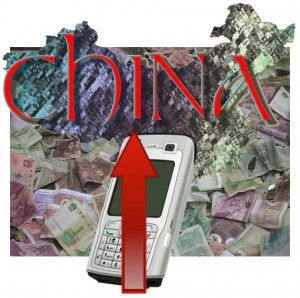While the market in the country is currently about half that of the United States, its growth rate is tremendous.
There is no doubt that mobile gaming is huge in China, despite the fact that it represents only a fraction of its complete video games market, and the fact that it is only about half of the size of the American market.
What makes the difference is the very rapid growth rate that the Chinese mobile games market is experiencing.
Mobile gaming is far lower, per capita, in the Chinese market than in the U.S. but the potential is only just starting to be tapped and the gap is about to close exceptionally rapidly. Currently, it is estimate that the market there is at around $9.7 billion (60 billion yuan). It has been consoles and, to a much greater extent, PC games that have been leading the way in terms of revenue in the country. However, the prediction now is that when compared to mobile devices, PC games may be about to lose their top position. This doesn’t necessarily mean that PC has no future, but it instead means that there is a great deal more room to grow in mobile.
Mobile gaming is accessible to a far larger number of people that haven’t tapped into it yet, in China.
 The lead held by PC games remains a very sizeable one, but the situation has shown that growth is starting to slow, simply because it is starting to reach a level of saturation. Those who have PCs and who will use them for gaming are already doing so, to a large extent. What makes the mobile games environment have such potential to take the lead is that there are far more smartphone users than computer owners in the country, and they are now starting to get into these apps with a vengeance.
The lead held by PC games remains a very sizeable one, but the situation has shown that growth is starting to slow, simply because it is starting to reach a level of saturation. Those who have PCs and who will use them for gaming are already doing so, to a large extent. What makes the mobile games environment have such potential to take the lead is that there are far more smartphone users than computer owners in the country, and they are now starting to get into these apps with a vengeance.
The growth in mobile gaming has been an amazing 400 percent, from having been 2.5 billion yuan a couple of years ago, to 125.2 billion yuan, last year. With an estimated three times more smartphone and tablet based gamers than there are on PCs, that shows that there is still quite a distance for mobile to go before it has reached its maturity.
Shopping over smartphones and tablets is moving ahead in a striking way within that country.
Emarketer has now released data that has shown that the m-commerce marketplace in China, representing shopping occurring over smartphones, tablets, and other types of mobile devices, will be reaching $334 billion, this year.
That figure represents a record breaking 49.7 percent of the total expenditure over online channels.
This prediction suggests that over 10 percent of the total retail sales in China will be occurring over m-commerce by next year. This trend in China is an important one, and it is an estimated 450 percent greater than what is going on in the United States. In the U.S., it is believed that sales over mobile commerce will rise by 32.2 percent. The retail sales over smartphones and tablets will represent 22 percent of the total online shopping. That said, from a broader perspective, they will make up only a tiny 1.6 percent of all retail sales in 2015.
This is microscopic next to China’s m-commerce portion of all sales, which is 7.9 percent.
 It is clear that the Chinese retail market is seeing notably faster and greater mobile commerce growth than the trend throughout the world. That said, its own marketplace continues its direction toward the digital sphere. Online retailers are working hard to ensure that they are continually prepared to evolve as consumers expect, and they are working hard to help to bring that same ease of shopping into areas of the country that are harder to reach.
It is clear that the Chinese retail market is seeing notably faster and greater mobile commerce growth than the trend throughout the world. That said, its own marketplace continues its direction toward the digital sphere. Online retailers are working hard to ensure that they are continually prepared to evolve as consumers expect, and they are working hard to help to bring that same ease of shopping into areas of the country that are harder to reach.
Two giants – JD.com and Alibaba – are making major investments into the rural communities of China, where there is the most room for online shopping growth within the country. In fact, the current rate of mobile commerce use is greater in the rural areas than it is in the large urban centers. This makes sense, considering that people in the major cities have a much greater availability and selection of products than those who are away from the ocean of brick and mortar shops.
That said, m-commerce needs to be implemented strategically. Even Alibaba has seen less than one tenth of its online purchases shipped to rural areas despite the massive potential there.
 The lead held by PC games remains a very sizeable one, but the situation has shown that growth is starting to slow, simply because it is starting to reach a level of saturation. Those who have PCs and who will use them for gaming are already doing so, to a large extent. What makes the mobile games environment have such potential to take the lead is that there are far more smartphone users than computer owners in the country, and they are now starting to get into these apps with a vengeance.
The lead held by PC games remains a very sizeable one, but the situation has shown that growth is starting to slow, simply because it is starting to reach a level of saturation. Those who have PCs and who will use them for gaming are already doing so, to a large extent. What makes the mobile games environment have such potential to take the lead is that there are far more smartphone users than computer owners in the country, and they are now starting to get into these apps with a vengeance.
 It is clear that the Chinese retail market is seeing notably faster and greater mobile commerce growth than the trend throughout the world. That said, its own marketplace continues its direction toward the digital sphere. Online retailers are working hard to ensure that they are continually prepared to evolve as consumers expect, and they are working hard to help to bring that same ease of
It is clear that the Chinese retail market is seeing notably faster and greater mobile commerce growth than the trend throughout the world. That said, its own marketplace continues its direction toward the digital sphere. Online retailers are working hard to ensure that they are continually prepared to evolve as consumers expect, and they are working hard to help to bring that same ease of 